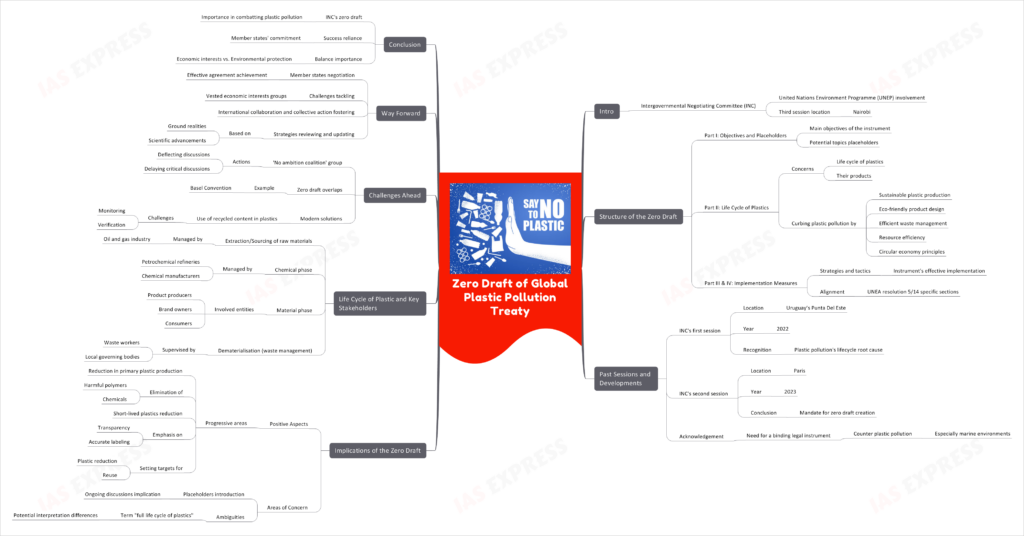Zero Draft of Global Plastic Pollution Treaty- Highlights, Implications & Challenges
From Current Affairs Notes for UPSC » Editorials & In-depths » This topic
IAS EXPRESS Vs UPSC Prelims 2024: 85+ questions reflected
The Intergovernmental Negotiating Committee (INC) recently unveiled a preliminary draft focused on addressing global plastic pollution. This initiative, steered by the United Nations Environment Programme (UNEP) and the views from INC’s prior sessions, will witness its third session in Nairobi, aiming to take substantial steps towards curbing the menace of plastic waste.

Structure of the Zero Draft
Part I: Objectives and Placeholders
- It delineates the main objectives of the instrument.
- Incorporates placeholders for potential topics that weren’t covered in the second session.
Part II: Life Cycle of Plastics
- Primarily concerns the life cycle of plastics and their products.
- Aims to curb plastic pollution by:
- Promoting sustainable plastic production and consumption.
- Emphasizing on eco-friendly product design.
- Prioritizing efficient waste management.
- Incorporating the principles of resource efficiency and a circular economy.
Part III & IV: Implementation Measures
- Enumerates various strategies and tactics to ensure the instrument’s effective implementation.
- Aligns with specific sections of the UNEA resolution 5/14.
Past Sessions and Developments
- INC’s first session in Uruguay’s Punta Del Este in 2022 recognized plastic pollution’s lifecycle as a root cause.
- INC’s second session in Paris in 2023 concluded with a mandate to create this zero draft.
- It acknowledges the need for a binding legal instrument to counter plastic pollution, especially in marine environments.
Implications of the Zero Draft
Positive Aspects
- The draft touches upon various progressive areas:
- Reduction in primary plastic production.
- Elimination of specific harmful polymers and chemicals.
- Reduction of short-lived plastics.
- Emphasizing transparency and accurate labeling.
- Setting specific targets for plastic reduction and reuse.
Areas of Concern
- The draft introduces placeholders, implying discussions are still underway on several essential aspects.
- Ambiguities exist around the term “full life cycle of plastics” leading to potential differences in interpretation.
Life Cycle of Plastic and Key Stakeholders
- Extraction/Sourcing of raw materials: Managed by the Oil and gas industry.
- Chemical phase: Handled by Petrochemical refineries and chemical manufacturers.
- Material phase: Involves product producers, brand owners, and consumers.
- Dematerialisation (waste management): Supervised by waste workers and local governing bodies.
Challenges Ahead
- A group termed the ‘No ambition coalition’ has been deflecting and delaying critical discussions.
- The zero draft potentially overlaps with other agreements, such as the Basel Convention.
- Modern solutions, like using recycled content in plastics, might be ahead of their time and hard to monitor or verify.
Way Forward
- Ensuring member states effectively negotiate and reach an agreement on this vital instrument.
- Tackling the challenges posed by groups with vested economic interests.
- Fostering international collaboration and collective action.
- Constantly reviewing and updating strategies based on ground realities and scientific advancements.
Conclusion
While the INC’s zero draft marks a significant step forward in combating plastic pollution, its eventual success relies heavily on member states’ commitment. The balance between economic interests and environmental protection will play a pivotal role in shaping the future of this initiative.
Practice Question for Mains
What are the highlights of the zero draft of the global plastic pollution treaty released in Nairobi? Discuss the implications and the way ahead. (250 words)
If you like this post, please share your feedback in the comments section below so that we will upload more posts like this.

